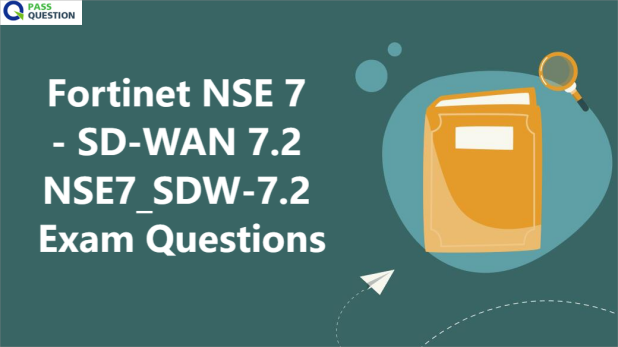Fortinet NSE 7 - SD-WAN 7.2 NSE7_SDW-7.2 Exam Questions
To obtain your FCSS in Network Security Certification, you can pass the NSE7_SDW-7.2 Fortinet NSE 7 - SD-WAN 7.2 exam as the elective exam to get certified. PassQuestion has recently launched the most up-to-date Fortinet NSE 7 - SD-WAN 7.2 NSE7_SDW-7.2 Exam Questions designed to cover all the important topics and concepts that you need to master to successfully pass your exam. These questions have been developed by industry experts and are regularly updated to ensure that they align with the latest exam syllabus. With the help of these Fortinet NSE 7 - SD-WAN 7.2 NSE7_SDW-7.2 Exam Questions, you can effectively enhance your knowledge and understanding of Fortinet NSE 7 - SD-WAN 7.2 and pass your Fortinet NSE7_SDW-7.2 exam easily.

FCSS in Network Security Certification
The FCSS in Network Security certification validates your ability to design, administer, monitor, and troubleshoot Fortinet network security solutions. This curriculum covers network security infrastructures using advanced Fortinet solutions. We recommend this certification for cybersecurity professionals who require the expertise needed to design, manage, support, and analyze advanced Fortinet network security solutions.
To obtain the FCSS in Network Security certification, you must pass the core exam and one elective exam within two years of difference.
Core Exam:
Fortinet NSE 7—Enterprise Firewall 7.0 (NSE7_EFW-7.0) or
Fortinet NSE 7—Enterprise Firewall 7.2 (NSE7_EFW-7.2)
Elective Exams:
Fortinet NSE 7—LAN Edge 7.0 (NSE7_LED-6.4)or
Fortinet NSE 7—Network Security Support Engineer 7.2 (NSE7_NST-7.2)or
Fortinet NSE 7—SD-WAN 7.2 (NSE7_SDW-7.2)
Fortinet NSE 7 - SD-WAN 7.2
The Fortinet NSE 7 - SD-WAN 7.2 exam evaluates your knowledge of, and expertise with, the Fortinet SD-WAN solution. The exam tests applied knowledge of the integration, administration, troubleshooting, and central management of a secure SDWAN solution composed of FortiOS 7.2.4, FortiManager 7.2.2, and FortiAnalyzer 7.2.2. The Fortinet NSE 7 - SD-WAN 7.2 exam is intended for network and security professionals who are responsible for the design, administration, and support of a secure SD-WAN infrastructure composed of many FortiGate devices.
Fortinet NSE7_SDW-7.2 Exam Information
Exam name: Fortinet NSE 7 - SD-WAN 7.2
Exam series: NSE7_SDW-7.2
Time allowed: 75 minutes
Exam questions: 40 multiple-choice questions
Scoring Pass or fail: A score report is available from your Pearson VUE account
Language: English
Product version: FortiOS 7.2.4, FortiManager 7.2.2, FortiAnalyzer 7.2.2
Fortinet NSE 7 - SD-WAN 7.2 NSE7_SDW-7.2 Exam Objectives
SD-WAN configuration
- Configure a basic SD-WAN DIA setup
- Configure SD-WAN Members and Zones
- Configure Performances SLAs
Rules and Routing
- Configure SD-WAN Rules
- Configure SD-WAN Routing
Centralized management
- Configure and deploy SD-WAN from FortiManager
- Configure and use IPsec recommended templates
- Configure and use SD-WAN Overlay Template
SD-WAN overlay design and best practices
- Deploy a hub-and-spoke IPsec topology for SD-WAN
- Configure ADVPN
SD-WAN troubleshooting
- Troubleshoot SD-WAN rules and sessions behavior
- Troubleshoot SD-WAN routing
- Explain output of SD-WAN diagnose commands
- Monitor and troubleshoot ADVPN
View Online Fortinet NSE 7 - SD-WAN 7.2 NSE7_SDW-7.2 Free Questions
1. Which diagnostic command can you use to show the member utilization statistics measured by performance SLAs for the last 10 minutes?
A. diagnose sys sdwan intf-sla-log
B. diagnose sys sdwan health-check
C. diagnose sys sdwan log
D. diagnose sys sdwan sla-log
Answer: D
2. Which two statements are correct when traffic matches the implicit SD-WAN rule? (Choose two.)
A. The sdwan_service_id flag in the session information is 0.
B. All SD-WAN rules have the default setting enabled.
C. Traffic does not match any of the entries in the policy route table.
D. Traffic is load balanced using the algorithm set for the v4-ecmp-mode setting.
Answer: A, C
3. What is the route-tag setting in an SD-WAN rule used for?
A. To indicate the routes for health check probes.
B. To indicate the destination of a rule based on learned BGP prefixes.
C. To indicate the routes that can be used for routing SD-WAN traffic.
D. To indicate the members that can be used to route SD-WAN traffic.
Answer: B
4. Which are three key routing principles in SD-WAN? (Choose three.)
A. FortiGate performs route lookups for new sessions only.
B. Regular policy routes have precedence over SD-WAN rules.
C. SD-WAN rules have precedence over ISDB routes.
D. By default, SD-WAN members are skipped if they do not have a valid route to the destination.
E. By default, SD-WAN rules are skipped if the best route to the destination is not an SD-WAN member.
Answer: BDE
5. In the default SD-WAN minimum configuration, which two statements are correct when traffic matches the default implicit SD-WAN rule? (Choose two)
A. Traffic has matched none of the FortiGate policy routes.
B. Matched traffic failed RPF and was caught by the rule.
C. The FIB lookup resolved interface was the SD-WAN interface.
D. An absolute SD-WAN rule was defined and matched traffic.
Answer: AC
6. What are two reasons for using FortiManager to organize and manage the network for a group of FortiGate devices? (Choose two)
A. It simplifies the deployment and administration of SD-WAN on managed FortiGate devices.
B. It improves SD-WAN performance on the managed FortiGate devices.
C. It sends probe signals as health checks to the beacon servers on behalf of FortiGate.
D. It acts as a policy compliance entity to review all managed FortiGate devices.
E. It reduces WAN usage on FortiGate devices by acting as a local FortiGuard server.
Answer: AE
7. Which statement is correct about SD-WAN and ADVPN?
A. Routes for ADVPN shortcuts must be manually configured.
B. SD-WAN can steer traffic to ADVPN shortcuts, established over IPsec overlays, configured as SD-WAN members.
C. SD-WAN does not monitor the health and performance of ADVPN shortcuts.
D. You must use IKEv2 on IPsec tunnels.
Answer: B
- TOP 50 Exam Questions
-
Exam
All copyrights reserved 2025 PassQuestion NETWORK CO.,LIMITED. All Rights Reserved.

